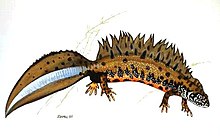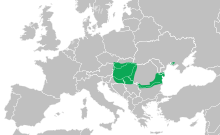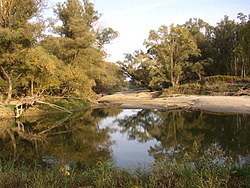Danube crested newt
| Danube crested newt | |
|---|---|

| |
| Scientific classification | |
| Domain: | Eukaryota |
| Kingdom: | Animalia |
| Phylum: | Chordata |
| Class: | Amphibia |
| Order: | Urodela |
| Family: | Salamandridae |
| Genus: | Triturus |
| Species: | T. dobrogicus
|
| Binomial name | |
| Triturus dobrogicus (Kiritzescu, 1903)
| |

| |
| Synonyms[2] | |
| |
The Danube crested newt or Danube newt (Triturus dobrogicus) is a species of newt found in central and eastern Europe, along the basin of the Danube river and some of its tributaries and in the Dnieper delta. It has a smaller and more slender body than the other crested newts in genus Triturus but like these, males develop a conspicuous jagged seam on back and tail during breeding season.
For half of the year or longer, adults live in slow-flowing river margins, lakes, or ponds, where reproduction takes place. Males perform a
Taxonomy
The Danube crested newt was described as a variety of the
Separated populations from the Danube Delta and the Pannonian Basin (see section Distribution and habitats) were described as two subspecies, T. dobrogicus dobrogicus and T. dobrogicus macrosoma, in 2000.[6] Later genetic study, however, did not support the distinction of these two forms.[7][8]
Description
Measuring 13 to 15 centimetres (5.1 to 5.9 in) long in total, sometimes up to 18 centimetres (7.1 in) in females,
The Danube crested newt's back and sides are dark brown with black spots and white stippling. The belly is orange to red (in other crested newts, it is usually yellow or orange–yellow), with small or medium-sized black blotches that have sharp edges. Like all crested newts, T. dobrogicus males develop a crest on their back and tail during breeding phase, which can be quite high and jagged, usually starts between the eyes and nostrils, and is interrupted at the tail base. Another feature of males at breeding season is a bluish-white stripe along the tail.[10]: 10–14 [9]: 345 Females can sometimes have a yellow stripe along the back, similar to the Italian crested newt (T. carnifex).[9]: 345
Distribution and habitats
The Danube crested newt is found in three
- Pannonian basin: From easternmost
- Lower Danube and Danube delta: Separated from the Pannonian basin by an area where the northern crested newt occurs, this central part ranges from southern Romania, northern Odesa region of southern Ukraine.[7]
- Bug rivers.[12]

In addition to the northern crested newt to the north, the Danube crested newt's range borders that of the Italian crested newt (T. carnifex) in the west, and that of the
: 16–17Compared to the other crested newt species, the Danube crested newt is more adapted to life along a river system and frequently occurs in flowing water and together with fish. Typical breeding sites are slow-flowing river margins,
Lifecycle and behaviour
Danube crested newts have the longest aquatic phase in the genus Triturus. Adults move to their breeding sites in February or March and usually stay there for six months; occasionally, they may even stay longer or return to the water in autumn.[10]: 44 [14]: 144–145 Males court females with a display of ritualised body movements. When they have gained the female's interest, they guide it over a spermatophore they deposit on the ground, which the female then takes up with her cloaca.[10]: 80–89 The eggs are fertilised internally. As in other crested newts, a female lays around 200 eggs per season, which are folded individually into leaves of aquatic plants. Eggs and larvae are smaller than in the other crested newt species, and they take longer (two to four months) until they reach metamorphosis and leave the water.[10]: 61–65 [9]: 345
Both in water and on land, the newts are largely nocturnal. In their aquatic habitats, they hide under vegetation, and on land, they use structures such as logs, rocks, or small animal burrows for cover.
Threats and conservation
The population of the Danube crested newt has declined significantly, and the
See also
References
- ^ . Retrieved 27 July 2022.
- ^ a b Frost, D.R. (2015). "Triturus dobrogicus (Kiritzescu, 1903). Amphibian Species of the World: an Online Reference. Version 6.0". New York, USA: American Museum of Natural History. Retrieved 2015-07-11.
- ^ Kiritzescu, C. (1903). "Contributions à la faune des batraciens de Roumanie". Buletinul Societatii de Sciinte Din Bucuresci, România (in French). 12: 243–265.
- PMID 21672214.
- ^ PMID 30630099.
- .
- ^ .
- S2CID 88449169.
- ^ ISBN 9789004285620.
- ^ ISBN 978-3-933066-44-2.
- ^ "Informacijski center za varstvo dvoživk Slovenije".
- ^ Litvinchuk, S.N. (2005). "A Record of the Danube Newt, Triturus dobrogicus, from the Dnepr River Delta (Ukraine)". Russian Journal of Herpetology. 12 (1): 69–72.
- ^ Gollmann, G.; Pintar, M. (2009). Erhebung des Donaukammmolches (Triturus dobrogicus) in der Lobau [Assessment of the Danube crested newt (Triturus dobrogicus) in the Lobau floodplain] (PDF) (Report) (in German). University of Natural Resources and Applied Life Sciences, Vienna.
- ^ ISBN 0-85661-100-X.
- ^ "Convention on the Conservation of European Wildlife and Natural Habitats". Bern: Council of Europe. 1979. Retrieved 2015-05-24.
- ^ Council directive 92/43/EEC on the conservation of natural habitats and of wild fauna and flora (1992L0043). 1 January 2007. Retrieved 2015-05-31.
External links



